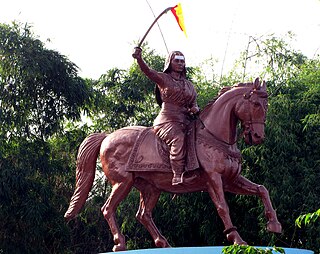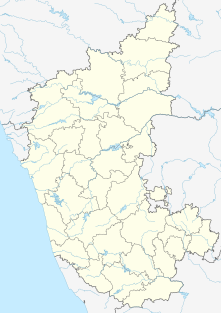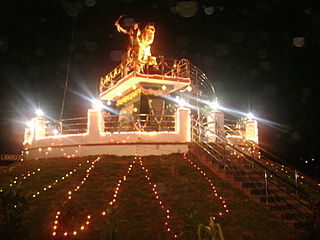
Belgaum is a city in the Indian state of Karnataka located in its northern part along the Western Ghats. It is the administrative headquarters of the eponymous Belgaum division and Belgaum district. The Government of Karnataka has proposed making Belgaum the second capital of Karnataka, hence a second state administrative building Suvarna Vidhana Soudha was inaugurated on 11 October 2012.

Gokak is a taluka headquarters in the Belagavi district of Karnataka state, India. It is located around 70 km from Belagavi at the confluence of two rivers, the Ghataprabha and the Markandeya. The population of the city is according to 2011 census is approximately 150,773. Gokak city has second highest GDP in the district of Belagavi after Belagavi city. The common language is Kannada.

Bailhongal is a Taluk in Belagavi District of Karnataka state in southern India. Bailhongal Taluk is located towards the north-east part of Belagavi. The taluk headquarters is about 44 km from the district headquarters. The total geographical area of the taluk is 1122.40 km2. There are 126 revenue villages and 14 hamlets with a total population of 356,400 people, according to the 2001 census.

Kittur, also known as Kitturu and historically as Kittoor, is a taluka in the Belgaum district of the Indian state of Karnataka. It was part of Bailhongal taluka but was declared as an independent taluka on 23 October 2012 by the Chief Minister of Karnataka on the inauguration of Kittur Utsav. It is 177th Taluk of Karnataka State. It is a place of historical importance because of the armed rebellion of Kittur Chennamma (1778–1829), Rani of the State of Kittur against the British East India Company, during which a British Commissioner, St John Thackeray was killed.

Kittur Chennamma was the Indian queen (rani) of Kittur, a princely state in present-day Karnataka. She led an armed rebellion against the British East India Company in 1824 in defiance of the doctrine of lapse in an attempt to maintain Indian control over the region, but was defeated and died imprisoned. One of the first female rulers to rebel against British rule, she has become a folk hero in Karnataka and symbol of the independence movement in India.

North Karnataka is a geographical region in Deccan plateau from 300 to 730 metres elevation that constitutes the northern part of the Karnataka state in India. It is drained by the Krishna River and its tributaries the Bhima, Ghataprabha, Malaprabha, and Tungabhadra. North Karnataka lies within the Deccan thorn scrub forests ecoregion, which extends north into eastern Maharashtra. Most parts of the region has black fertile soil ideal for agriculture.

Hukkeri is a Town Municipal Council and taluka in Belagavi district in the Indian state of Karnataka. Archeological studies reveal that the name Hukkeri is supposed to have been derived from the word Huvinakeri which means Street of Flowers. During Adil Shahi times, roses of good quality were grown here and were sent to Bijapur.

Khanapur is a panchayat town in Belagavi, Belgaon district, Karnataka, India. It is about 26 km from Belagavi. The town is governed by the Khanapur Municipal Council. Khanapur is the headquarters for Khanapur Taluq. The town is on the Belgaum-Panaji National Highway, NH 4A. Khanapur is well connected by train and road to important cities in Karnataka, Goa, and Maharashtra. Kannada is the official language but Marathi is widely spoken in the town. 60% local population speaks Marathi as it shares its borders with Goa and Maharastra.
The Belgaum border dispute is a dispute involving the Indian states of Karnataka and Maharashtra. Belgaum is a part of Karnataka and was earlier part of the British India's Bombay Presidency. The Bombay Presidency encompassed present day Gujarat, Maharashtra as well as certain areas of Karnataka.

Athani is a city in the Belagavi district of Karnataka, India. It is 140 kilometers from the city of Belagavi, 70 kilometers from Vijayapura, 55 kilometers from Miraj, 100 kilometers from Kolhapur, and 624 kilometers from Bengaluru.

Examba is a City and Municipal Council in the Belgaum district of the Indian state of karnataka.

Madabhavi is a large village located in Athani taaluk of Belagavi district, Karnataka state of India. The village is famous for production leather chappals which have main market in Kolhapur. The village name came from Madya means central and Bhavi means open well. Open well is near panchayat of village.This village Has two Oldest Ancients Temples one Kalbhairava and another one is Madhukeshwar temple.

Raibag (Rural) is a town in the southern state of Karnataka, India. It is located in the belagavi district of Karnataka.

Belgaum Fort is in the city of Belgaum, in the Belgaum district, in Karnataka state, India. It was begun by Jaya Raya, also called Bichi Raja, an ally of the Ratta Dynasty, in the year 1204 AD. It has undergone several renovations over the centuries under dynastic rulers of the region.

The Rani Chennamma Express is a daily train connecting the City of Bengaluru, Karnataka with city of Miraj, Sangli District of Maharashtra. This is one of the prestigious trains of the South Western Railway and generally gets the best coaches and locomotives that the infrastructure can support. This train operates daily and covers a distance of 749 km.This train ran up to Miraj Junction till 2002. Further extended up to Kolhapur in 2002 Railway Budget. Railway board confirms the origination & Termination of Rani chennama Exp again from Miraj as per Zero base time table.
Dodwad is a village in Belgaum district in the southern state of Karnataka, India.

Krishna-kittur is a village in the southern state of Karnataka, India. It is located in the Athani taluka of Belgaum district in Karnataka.
Sangolli is a village in Bailahongal taluk of Belgaum district Indian State of Karnataka, India.This is the birthplace of prominent warrior, Rayanna, from Karnataka, India. He was the army chief of the Kingdom of Kittur ruled at the time by Rani Chennamma and fought the British East India Company till his death. His life was the subject of the 2012 Kannada film Sangolli Rayanna.
Ratta dynasty was a minor Indian dynasty who ruled over the Belgaum region of modern Karnataka as a branch of Rashtrakutas. Savadatti (Saundatti), historically known as Sugandavarti was the capital of Ratta dynasty during 875-1250 CE period. Later their capital shifted to Belagavi (Belgaum) which is historically known as Venugrama. Belgaum was the capital of the Rattas during 1210 - 1250 AD. Rashtrika is a sanskritized form of Ratta. Hooli was also under the rule of Rattas of Saundatti.

Kadamba architecture was a style of temple architecture founded by Mayurasharma in the 4th century AD in Karnataka, India. Kadambas created new style of architecture which was the basis of the Hoysalas style of architecture, developed original school of sculpture, was the forerunner of series of South Indian sculptors. Many temples at Aihole, Badami and Hampi are built in Kadamba style.












